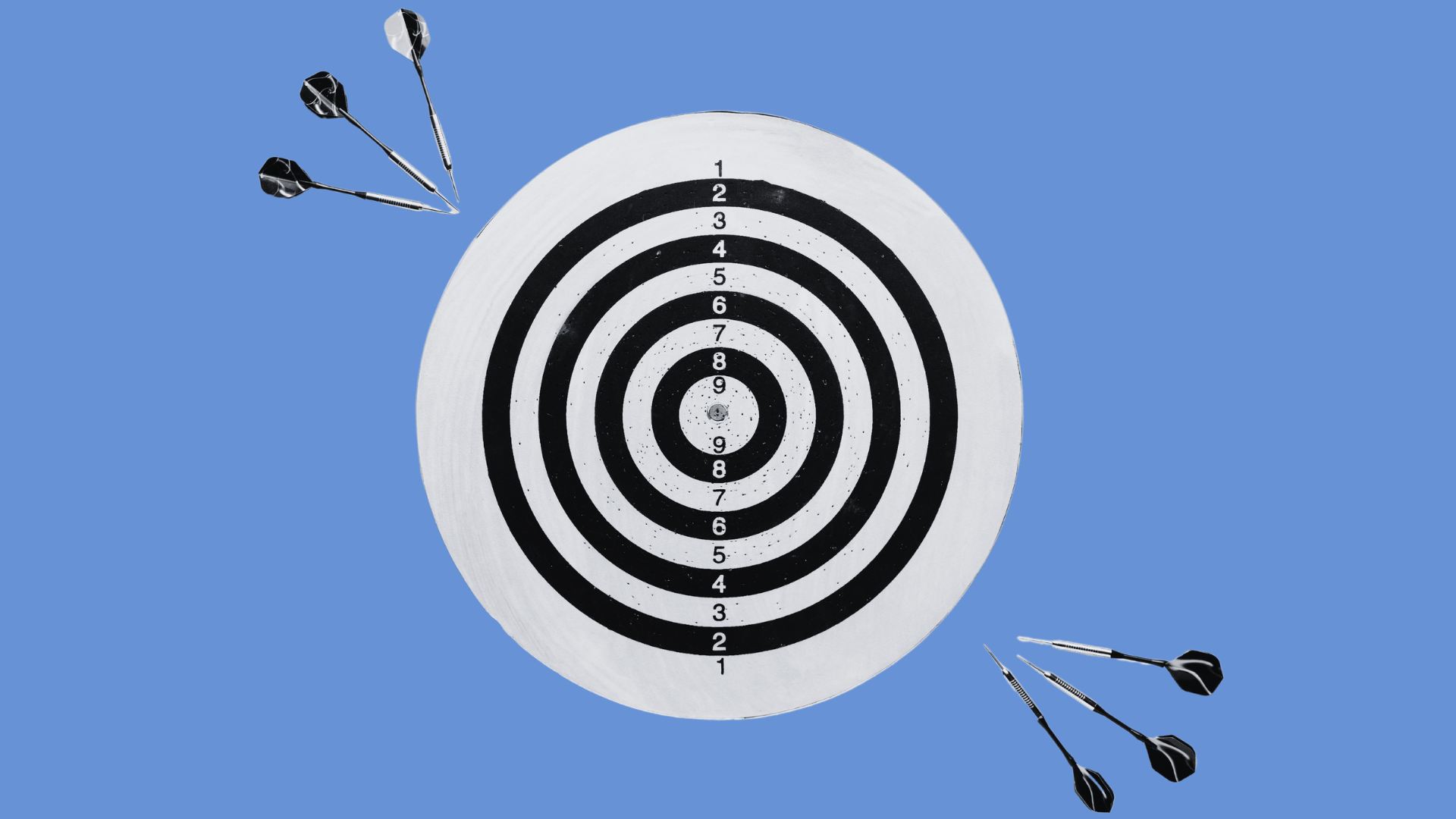
Not every time is the right time for real-time marketing.
Editor’s note: This article is based on previously written piece for the Centre for Business and Development Studies.
As the global Covid-19 pandemic spread through Europe and North America, companies raced to communicate how they were responding to the crisis. Advertising that focuses on a company’s response to humanitarian crises is hardly new. Every holiday season features a parade of brands touting their seasonal partnerships with charitable causes. Yet these exercises in “Covid-branding” struck a particular nerve with both consumers and media commentators because so many of the brands stuck to the same script. Quickly that script even became the subject of satire.
‘The hallmarks of the coronavirus ad are so consistent they could be generated by bots. They begin with eerie drone footage of empty streets, a shot of a child staring plaintively out the window and then — cue the upbeat musical key change — a medical worker peeling off a mask, a guy jamming on a home piano, maybe a deeply pregnant woman rubbing her belly as if summoning a genie from its bottle.’
Amanda Hess, The New York Times, May 22, 2020
These patterns are important. In the uncertain early weeks of the pandemic, as governments were still crafting their responses, the stories brands told played a role in shaping how the public made sense of the crisis. What kind of a crisis was it? What sort of solutions did it need? What role should business play in delivering them? Covid-branding offered answers to those questions.
In this briefing note, we present a preliminary analysis of Covid-branding by companies in Europe and North America during March and April 2020. Our analysis finds that messaging clustered clearly into two ways could engage: ‘Covid-helping’ and ‘Covid-coping.’ These messages of ‘managing the pandemic’ and ‘managing yourself’ frame the consumption of goods and services as a way that consumers can show they care, presenting shopping as a form of everyday heroism. In this way, they make the case that private sector has a role to play in humanitarian response.
Economic Context
The Covid-19 pandemic has taken an extraordinary toll on the global economy. Measures to combat the spread of the virus, including border closures, and national lockdowns affecting one-third of the world’s population, shut down much industrial production and pushed white-collar professionals to remote work. These measures, coupled with a fall in consumers’ own confidence in response to the health crisis, contributed to rising unemployment, falling consumer activity, and the worst global recession since the Great Depression.
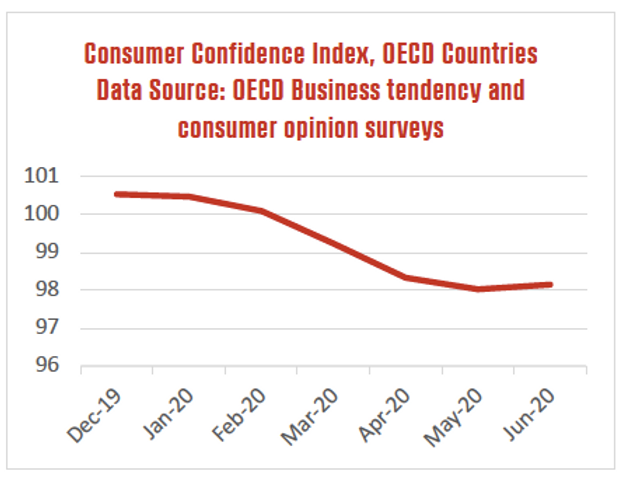
This context, with consumer activity declining overall and shifting from closed stores to online retailers, placed pressure on brands to compete for a share of the smaller e-commerce pie. At the same time, the recession placed pressure on marketing professionals to demonstrate their relevance at a time of overall corporate retrenchment.
Marketing Context
We focus our analysis on online communications, especially social media output. Social media marketing is often informal in tone and crafted quickly to respond to real-time events, so that brands can ride the waves of attention paid to viral news stories, from royal babies to sporting events.4 Most research about this practice has suggested brands choose to focus on positive or neutral stories to avoid mistakes, as humorous tweets about a serious event can backfire. That makes Covid-branding in the early weeks of the pandemic, when infection and death rates were rising, unusual.
We also examine promotional emails and newsletters, a form of content marketing. Content marketers have begun to develop more journalistic skills, including as storytellers and explainers of complex phenomena, and indeed many former journalists are employed as content marketers. Covid-branding, in which brands help consumers make sense of the emerging crisis, is an example of this phenomenon.
These online forms have not received much attention from researchers of corporate humanitarianism, which has focused on more traditional forms of print and broadcast advertising. We hope that this brief typology of how marketers used these newer forms in the Covid-19 pandemic encourages further research into these formats.
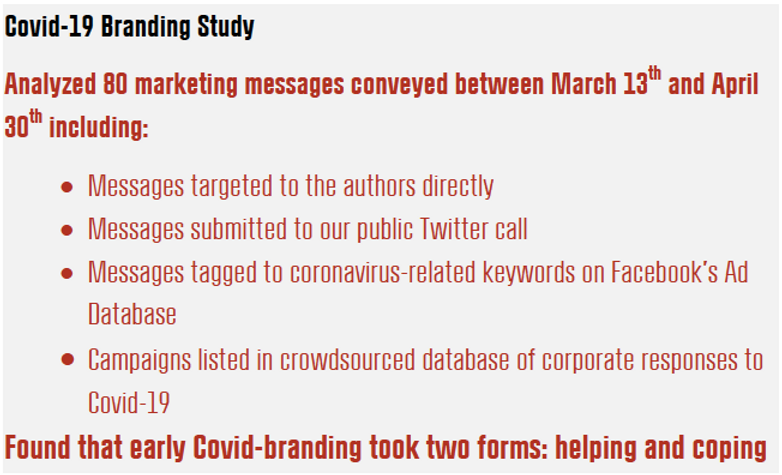
Covid-Branding as Covid-Helping
Brands that emphasized their role in helping to manage the pandemic did so in distinct ways. To understand this, we considered two aspects of each marketing message: First, whether companies are making an engaged or disengaged intervention. Companies which are engaged use their own business capacities toward the Covid-19 cause. Second, we consider whether companies are claiming to directly or indirectly impact the Covid-19 crisis itself. We investigate whether the brand claims to address the medical situation (direct) or indirect societal outcomes of the pandemic, including economic impacts.
The Four Modes of Engagement
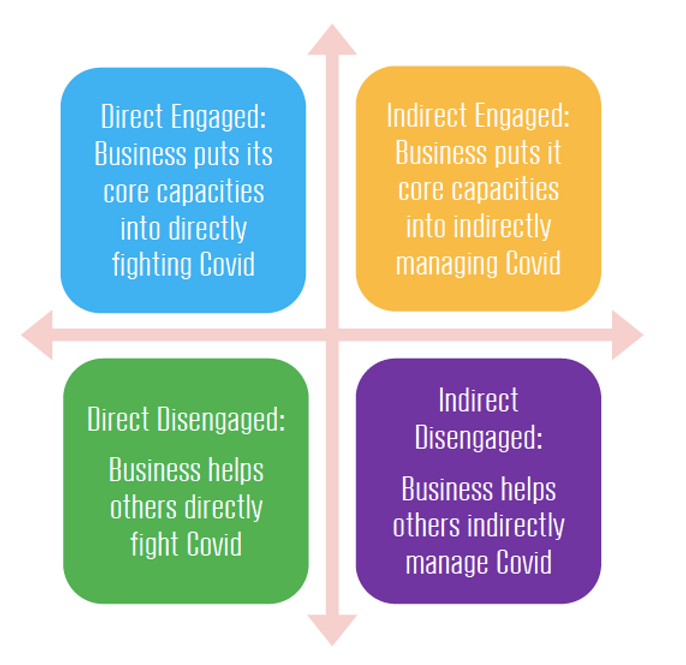
Direct Engaged: Business Puts Its Core Capacities Into Directly Fighting Covid
Some companies with core operations in the fields directly linked to fighting the pandemic (i.e. health care or logistics companies) quickly began communications around their role.
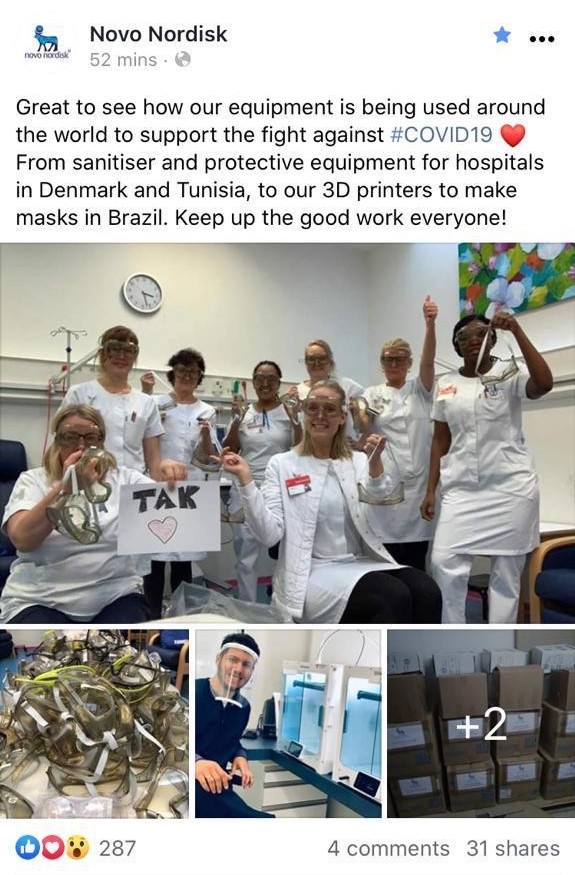
This Novo Nordisk Facebook advertisement shows healthcare workers holding up a sign reading “Thanks” in Danish. Novo Nordisk is a leading pharmaceutical company. Photographs of healthcare professionals at work in Novo Nordisk-made protective gear signaled company’s direct engagement.
Examples of countries where these products are in use underscores that the company serves a modern, global, and racially and gender-diverse group of professionals. Other direct engagement included shipping company Mærsk tweeting about “Mærsk Bridge,’ an air bridge and supply chain operation to transport PPE to healthcare workers.
Indirect Engaged: Business Puts Its Core Capacity Into Indirectly Managing Covid
Since direct business engagement was only possible for companies whose core business was in medical or logistical operations, many companies emphasised managing indirect societal impacts of the pandemic in their early response.
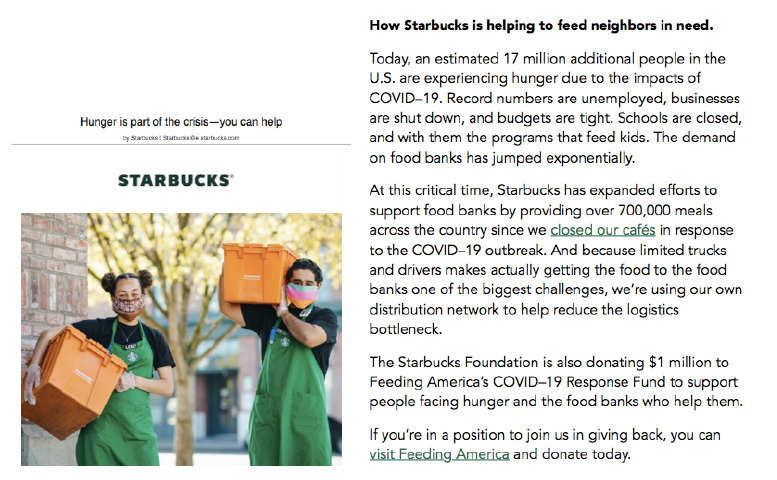
As a food and drinks business with a national supply chain, Starbucks was able to use its core capacities to address indirect economic impact of pandemic on food supply. Promotional email highlights corporate donations of 700,000 meals to food banks and use of company logistics network to assist foodbanks with transport.
Makes the case that hunger “is part of the crisis” to underscore relevance of this indirect engagement.
Other indirect engagement included Draper James, the American actress Reese Witherspoon’s fashion brand, announced on its Instagram account on April 2, donations of dresses for teachers (deemed essential workers during pandemic); campaign backfired when dress supplies ran out.
Direct Disengaged: Business Helps Others Directly Fight Covid
Businesses who could not easily link their core operations to medical needs instead highlighted partnerships to help others managing the Cover crisis.
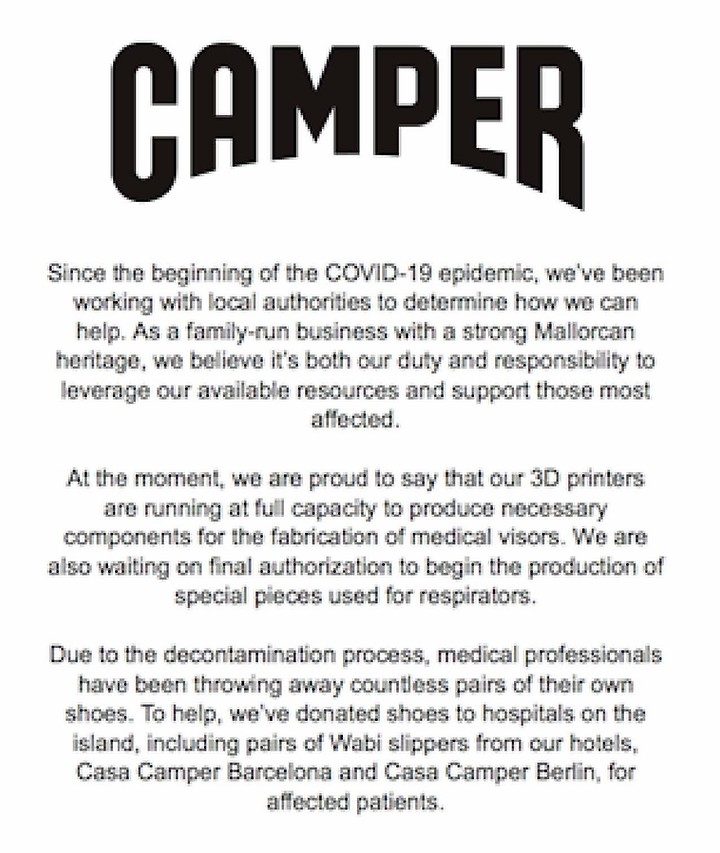
A promotional email from Camper highlights the use of 3D printers from its manufacturing operation to produce medical visors. The Email also highlights donations of shoes and slippers to staff and patients in hospitals.
Camper does not claim that they are themselves engaged in work to combat the medical crisis, but rather that they are making resources and equipment available to others who can do so.
Other direct disengaged examples included fashion brand Armedangels making cloth masks while explicitly stating on Facebook that they could not protect the wearer – “we can’t produce medical masks” – but that 2 euro from the sales of each mask would be donated to Doctors Without Borders, or gas company Crusoe Energy Systems announcing that they were donating computing power to Stanford University coronavirus research.
Indirect Disengaged: Business Helps Others Indirectly Manage Covid
Businesses who could not easily link their core operations to urgent economic or societal needs instead highlighted partnerships to help others managing the impact of the Covid crisis.
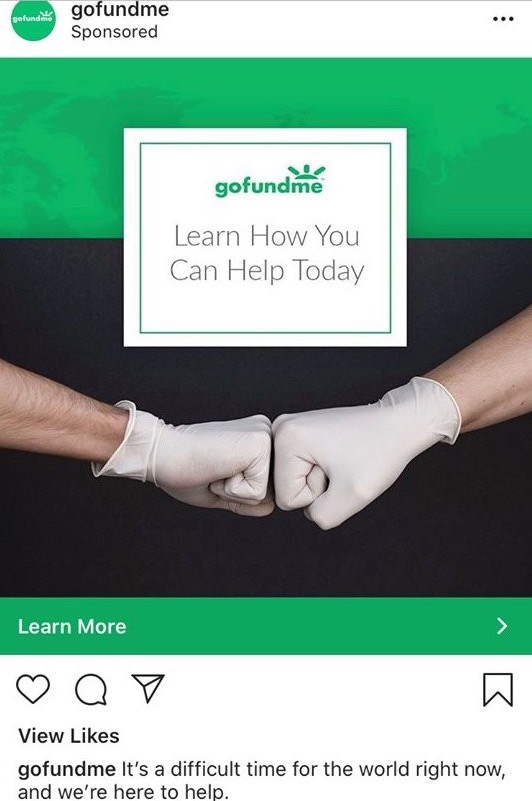
Instagram post by crowd-funding platform GoFundMe promoting that its platform can be used by consumers to identify causes to support. Following the link to “learn more” shows company also offering free consulting to nonprofits on how to raise additional funds.
The company is not mobilizing its own resources to support Covid-related causes, but rather facilitating donations to other organizations through information sharing. Such consulting activity is not an ordinary part of the company’s core business.
Other indirect disengaged examples included Facebook offering grants for small businesses in the United States and using its network to promote the existing loan program from the US government.
Covid-Branding as Covid-Coping
Many brand engagements we examined did not make any claims to be helping combat the crisis, or its social impact, at all. Rather they focused on helping individual consumers to cope with the circumstances surrounding the crisis and its personal impact on themselves.
Because these “Covid-coping” messages focused on helping individuals, rather than society or the economy, our analysis focused on the demographics of what kind of consumers each type of “coping” message addressed, as well as what the messages said. We identified three coping mechanisms brands sold to consumers in these Covid-coping messages: coping-through-practicality, coping-through-pleasure and coping-through-denial.
1) Coping-Through-Practicality
Like indirect Covid-helping, it portrays shopping as way to address consequences of the pandemic, but instead of focusing on consequences for society, it targets how consumers can address their own needs.
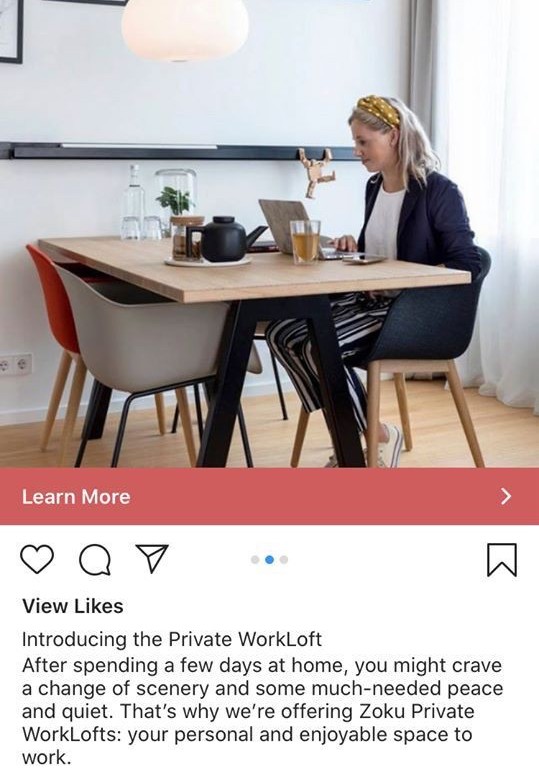
An Instagram post by Zoku, a real estate company managing coworking spaces, offered private office rooms for professionals needing a socially distant office away from their household. Emphasis is put on a spare and clean layout of the office and “peace and quiet” for workers.
It suggests appeal to professionals with children struggling with disruption to work practices in shared family homes. Coping-through-practicality engagements largely addressed themselves to consumers in their identities as professionals and parents.
Other coping-through-practicality examples included laptop manufacturers advertising tools for working from home; home furnishings brands advertising tools for cooking at home; and phone, internet and electricity providers advertising their services as essential infrastructure for remote working and home-schooling. Marketing of this type emphasizes how brands could help families and businesses carry on “as normal” during a period of crisis.
2) Coping-Through-Pleasure
Exclusively comprised of brands in the fashion, fitness and lifestyle industries, with messages targeted to young and predominantly white women; present luxury goods as means of coping with pandemic through ‘self-care’.
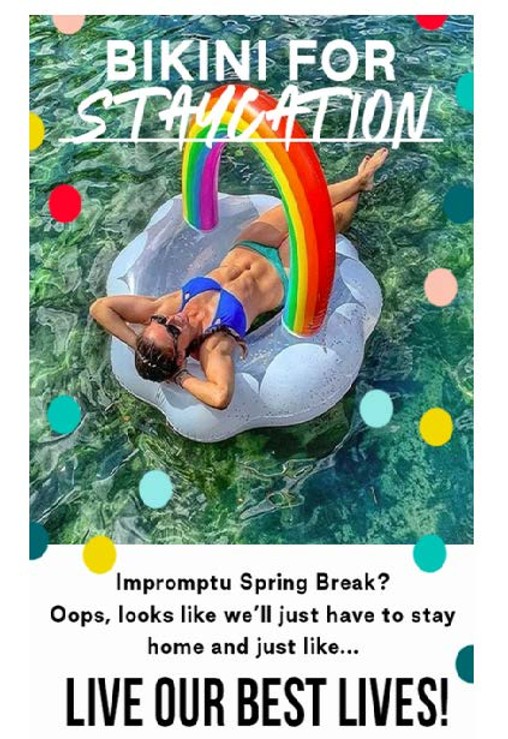
A promotional newsletter for the “athleisure” brand Jolyn depicts a slim and muscular white woman on an inflatable pool float wearing sunglasses and painted toenails. Sunlight appears to reflect off the body of water in which she floats, with a caption advertising a “Bikini for staycation.” The Image and caption present the lockdown, which compelled individuals to stay home from their usual recreational activities, as a “staycation,” an unexpected source of free time at home.
Other coping-through-pleasure messages included advertisements from fashion brands including Anthropologie and Nicole Miller advertising loungewear as “self-care style” and clothing for “virtual dates or happy hours,” as well as make-up brands offering online tutorials for those with “more time (inside) on our hands.”
These messages present the health crisis as an opportunity for women to take a “break” from work outside the home and relax with home-bound versions of their usual recreational activities. They draw on influencer culture, which depicts recreation as a full-time occupation. Coping-through-pleasure offers the chance to purchase some of the influencer lifestyle, where the pandemic is not a stressor, and one can escape at a moment’s notice to a sunlit pool.
3) Coping-Through-Denial
Targeted widely to all consumers, these messages suggested that consumers shop as though the pandemic were not taking place, or advertised products which made light of the pandemic.
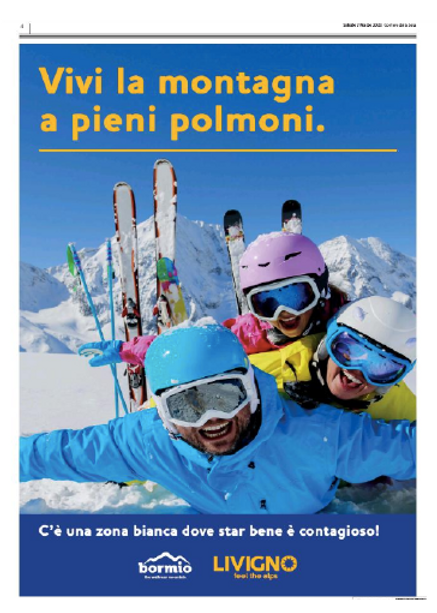
A full page newspaper advertisement in Corriere della Sera, Italy’s mostread newspaper, on 7 March, by two Italian ski resorts, Bormio and Livigno, captioned “Live the mountain with full lungs: There’s a snowy place where feeling great is contagious!”
At the time of advertisement running, lockdown was dissuading tourists from traveling to Italy, putting pressure on ski resorts, while deaths from the respiratory virus – which kills by targeting the lungs specifically – were at their highest in northern Italy, where ski resorts are concentrated.
Other coping-through-denial advertisements included Passports, a travel rewards program, contacting members in mid-March, when concerns about virus spread were focused on cruise ships, to advertise “the best pricing and exceptional bonuses” on celebrity cruises, and online retailers of topical and humorous T-shirts advertising limited range clothing with coronavirus-related captions. Notably, these engagements came broadly from the early weeks of our sample, and brands appeared to shy away from explicitly seeking to make light of the crisis or encouraging consumers to travel in spite of it, by the end of March 2020 when more severe lockdown and suppression measures were in place across Europe.
Implications for Brands
The different types of early Covid-branding in our sample, whether they focus on helping or coping with the pandemic, offer some cautionary lessons for brands.
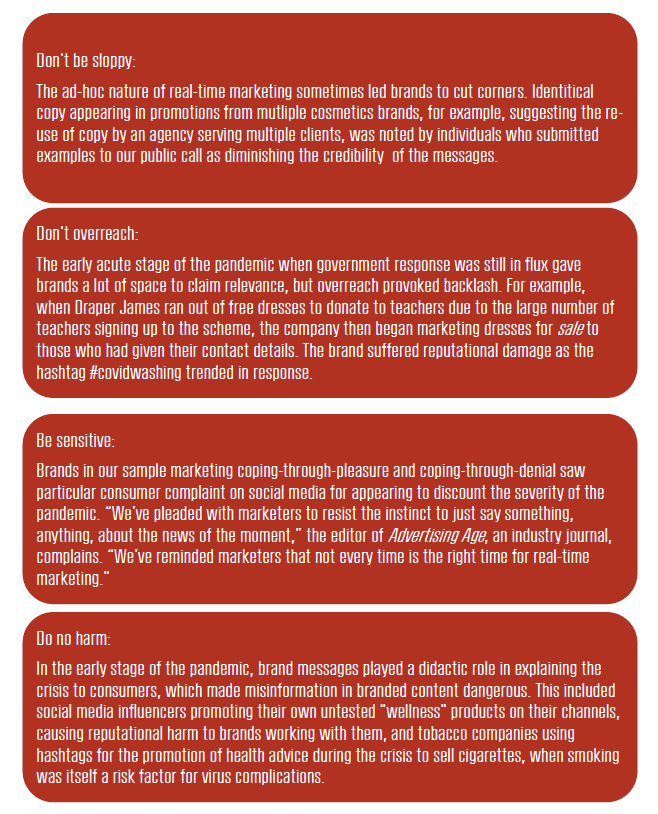
About Commodifying Compassion
‘Commodifying Compassion: Implications of Turning People and Humanitarian Causes into Marketable Things’ is a research project focused on understanding how ‘helping’ has become a marketable commodity and how this impacts humanitarianism. An international team of researchers funded by the Danish Council for Independent Research (2017-2021), we examine ethical consumption intended to benefit humanitarian causes from the perspectives of consumers, businesses, NGOs and recipients. The research will produce a better understanding by humanitarian organizations and businesses leading to more ethical fundraising, donors weighing consumption-based models as part of more effective aid, and consumers making more informed choices about ‘helping’ by buying brand aid products. To learn more about our work, visit the website.

Maha Rafi Atal is a postdoctoral research fellow at the Copenhagen Business School, where her research focuses on corporate power, corporate social responsibility and corporate influence in the media. She is a co- Investigator on the Commodifying Compassion research project. http://www.maha-rafi-atal.com

Lisa Ann Richey is Professor of Globalization at the Copenhagen Business School. She works in the areas of international aid and humanitarian politics, the aid business and commodification of causes. She is the principal investigator on the Commodifying Compassion research project. https://www.lisaannrichey.com



